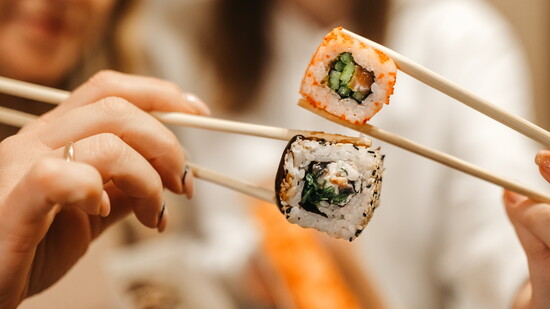Sushi in America has become its own species. You can grab a California roll at a gas station, eat “dragon rolls” the size of burritos, and dunk your tuna in soy sauce like it’s a swimming pool. But here’s the truth: we’ve been eating it all wrong. The Japanese have been quietly shaking their heads for decades. Let’s set the record straight—with chopsticks firmly down.
The 10 Sushi Sins
1. Chopstick Addiction
Nigiri—the classic fish-over-rice bite—was designed to be picked up with your fingers. It’s literal finger food. Chopsticks are fine for sashimi, but otherwise? Hands are not only acceptable, they’re the correct choice. Bonus: no more rice casualties raining down your shirt.
2. Soy Sauce Dunk Tanks
We just looooove to drown our sushi in soy sauce. In Japan, chefs brush on a whisper of sauce themselves—just enough to highlight, never to smother. If you do dip, it’s fish side only, not rice side first.
3. Wasabi Wannabes
That neon green lump next to your roll? It’s almost never real wasabi. Nine times out of ten it’s a cosplay of horseradish, mustard powder, and food coloring. Actual wasabi is grated fresh, herbal, and loses its flavor in minutes. And here’s the kicker: chefs already tuck it neatly between fish and rice. Stirring it into soy sauce until it looks like swamp water? Pure American improv.
4. Ginger Is Not A Topping
Ginger is the intermission, not the main act. It’s meant to cleanse your palate between bites, not sit on top of your salmon like a floppy pink hat. Sushi chefs in Japan would never garnish with ginger—it’s like squirting ketchup on a filet mignon.
5. Chopstick Sanding
That habit we all have of rubbing disposable chopsticks together to “get rid of splinters”? In Japan, it’s basically telling the restaurant their chopsticks are trash. Unless you’re actually pulling out wood shards (and you’re not), keep them smooth and still.
6. The Two Bite Tragedy
That nigiri isn’t meant to be split in half like a burger. The chef crafted the rice, fish, and wasabi to balance perfectly in one go. Open wide.
7. The Instagram Delay
Sushi is served to be eaten immediately. Temperature, texture, and freshness fade fast. In Japan, it’s bite-now-or-never. (Instagram later.)
8. Flavor Whiplash
Light, delicate fish first, richer cuts next, bold flavors last. Think of it like a tasting menu, not a free-for-all roll scramble.
9. Sake Bombing Your Omakase
Surprise: sake isn’t the traditional drink with sushi. Rice on rice? Too much. The Japanese go for tea, beer, or shochu instead.
10. The Premature Souping
Miso soup is a closer, meant to warm and settle your stomach at the end of the meal.
Sushi is simple, clean, balanced. Which is exactly why our American habits—volcano rolls, mayo drizzles, deep-fried “everything”—look a little extra from across the Pacific. By all means, keep your spicy tuna rolls and sushi burritos—Japan isn’t coming for them. But if you want to do it right? Trust the chef, eat with your hands, chill on the soy… and for the love of all things seaweed, stop mixing wasabi into it.
Ginger is the intermission, not the main act. It’s meant to cleanse your palate between bites, not sit on top of your salmon like a floppy pink hat.
